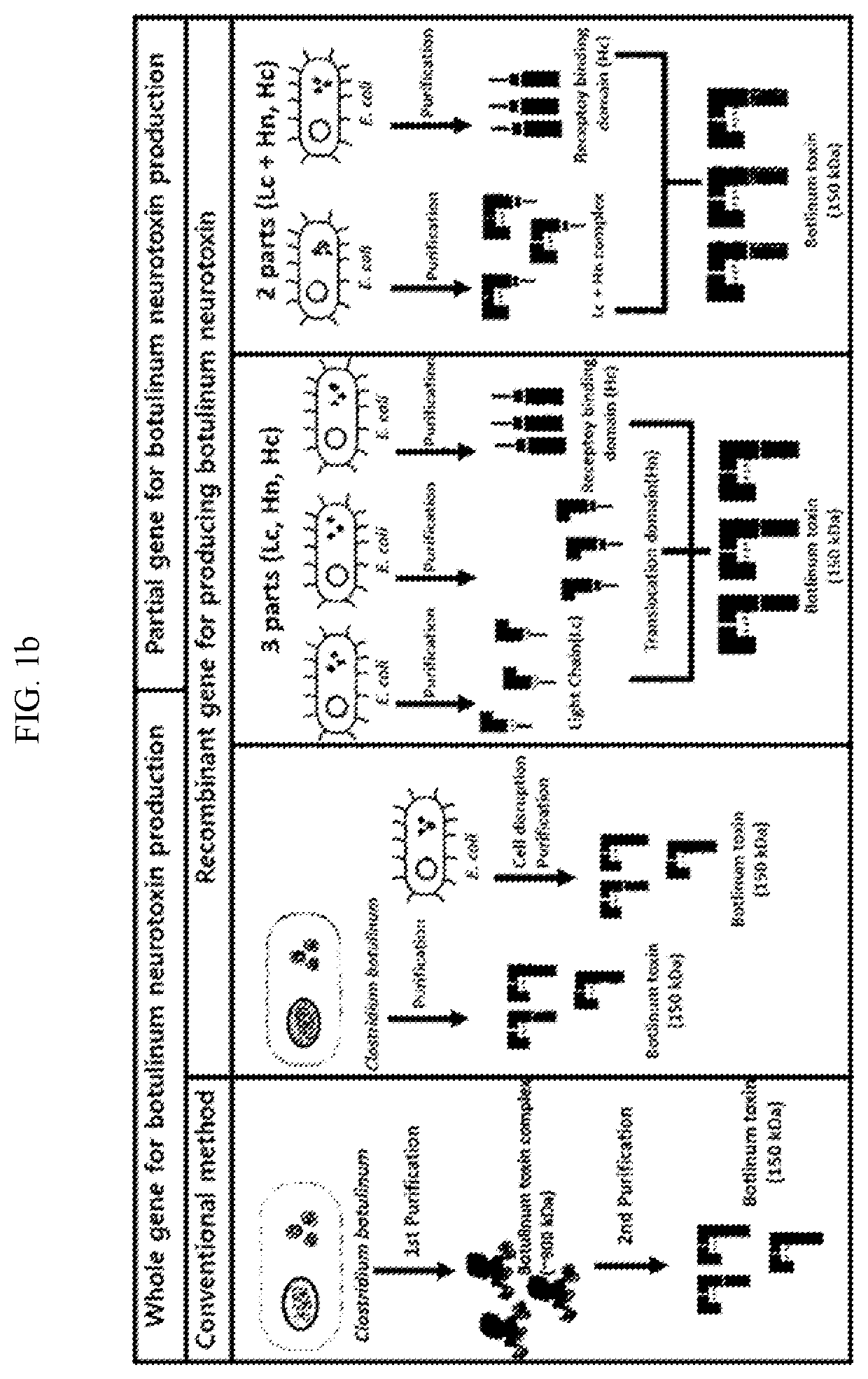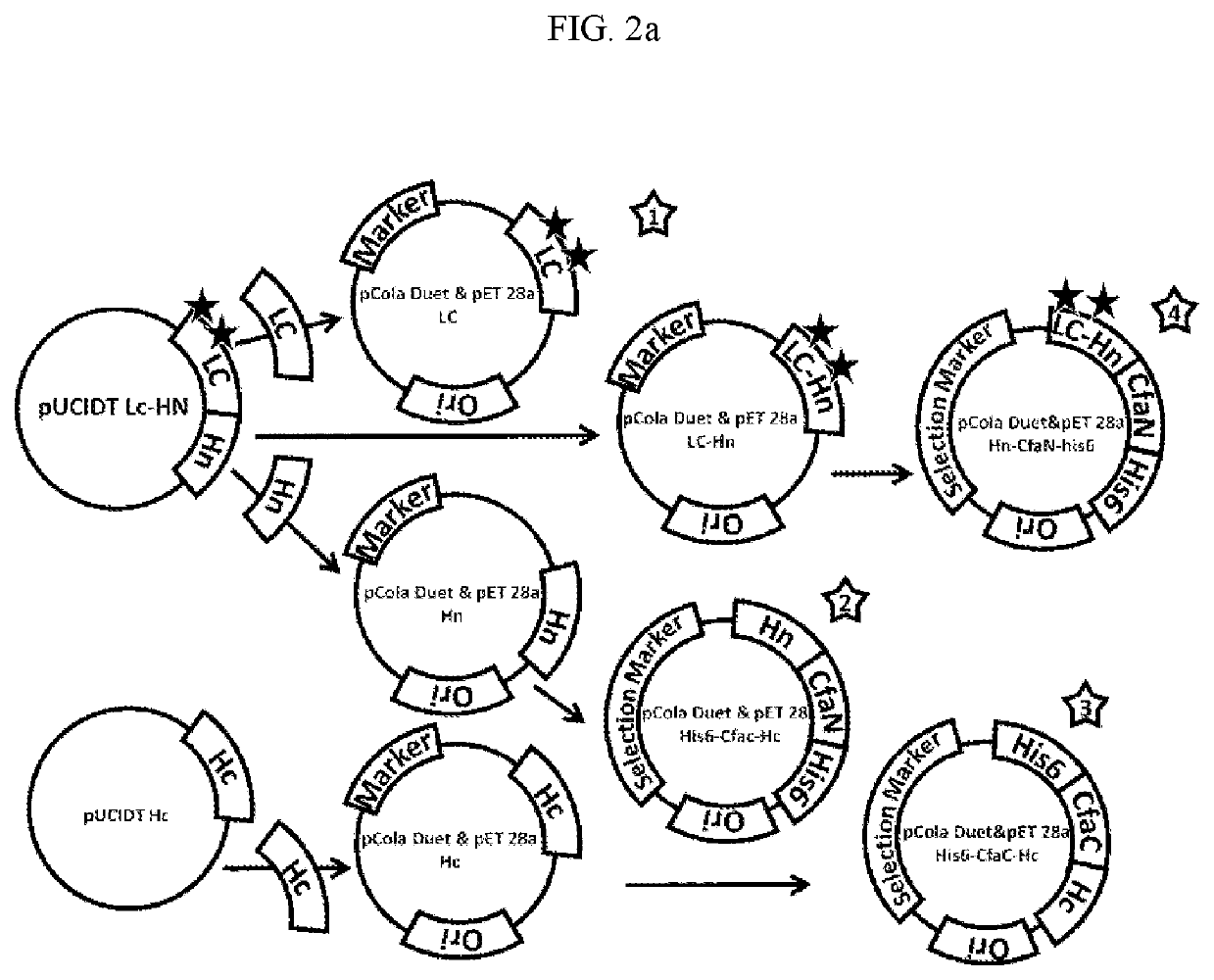Method for safely producing botulinum neurotoxin
- Summary
- Abstract
- Description
- Claims
- Application Information
AI Technical Summary
Benefits of technology
Problems solved by technology
Method used
Image
Examples
example 2
ation of Soluble Expression of Botulinum Toxin Split Fragment
[0109]A botulinum toxin split protein was produced using the plasmids produced in Example 1. Specifically, heat shock was applied to the E. coli BL21 (DE3) strain transformed with competent cells at 42° C. for 45 seconds, and the E. coli BL21 (DE3) strain was stabilized on ice and transduced with the plasmids produced as described above. The transduced E. coli was plated on LB ampicillin solid selective medium and then incubated at 37° C. for one day. One colony grown in the selective medium was added to 10 mL of liquid LB medium, added with 10 μL of kanamycin, and then pre-cultured at 37° C. for 12 hours. The pre-cultured recombinant strain was inoculated at 1% in 50 mL LB medium supplemented with kanamycin and cultured at 37° C. until the O.D. (at a wavelength of 600 nm) reached 0.5. Then, the strain was added with 0.1 mM IPTG and cultured at 16° C. for 24 hours. The resulting culture solution was centrifuged at 5,000 rp...
example 3
th Botulinum Toxin Production Through Reconjugation of Botulinum Toxin Split Fragments
[0111]3-1. Purification of Botulinum Toxin Fragments and Reconjugation Thereof Using Protein Trans-Splicing
[0112]Each fragment was produced in the same manner as in Example 2 using the plasmids produced in Example 1. Specifically, heat shock was applied to the E. coli BL21 (DE3) strain transformed with competent cells at 42° C. for 45 seconds, after which the strain was stabilized on ice and transduced with the plasmids produced above. The transduced E. coli was plated on LB ampicillin solid selective medium and then incubated at 37° C. for one day. One colony grown in the selective medium was added to 10 mL of liquid LB medium, added with 10 μL of ampicillin, and then pre-cultured at 37° C. for 12 hours. The pre-cultured recombinant strain was inoculated again in 50 mL LB medium supplemented with ampicillin at 1% and incubated at 37° C. until the O.D. (at a wavelength of 600 nm) reached 0.5. Then,...
example 4
ion of Dimer Formation Through Disulfide Bond Formed in Cysteine after Trans-Intein Splicing
[0117]SDS-PAGE and size exclusion chromatography (SEC) were used to determine whether or not two LC-HN-HC formed a dimer through the disulfide bond in the cysteine newly generated in the splicing process of Example 3-1. Specifically, in the same manner as in Example 2, electrophoresis was performed using SDS-PAGE. At this time, a 6× SDS solution containing DTT, which serves to cleave disulfide bonds, and a solution not containing DTT were compared. In addition, a graph was drawn using SEC, and the size of the full-length toxin was observed in order to identify the presence or absence of disulfide bonds.
[0118]The result showed that bands were formed at 150 kDa in the graph of the electrophoresed gel and SEC of the sample using the solution containing DTT, whereas the band was formed at 300 kDa of the sample using the solution containing no DTT. This indicates that the toxin formed a dimer thro...
PUM
| Property | Measurement | Unit |
|---|---|---|
| Length | aaaaa | aaaaa |
| Affinity | aaaaa | aaaaa |
Abstract
Description
Claims
Application Information
 Login to View More
Login to View More - R&D
- Intellectual Property
- Life Sciences
- Materials
- Tech Scout
- Unparalleled Data Quality
- Higher Quality Content
- 60% Fewer Hallucinations
Browse by: Latest US Patents, China's latest patents, Technical Efficacy Thesaurus, Application Domain, Technology Topic, Popular Technical Reports.
© 2025 PatSnap. All rights reserved.Legal|Privacy policy|Modern Slavery Act Transparency Statement|Sitemap|About US| Contact US: help@patsnap.com



